battery capacity TOYOTA RAV4 HYBRID 2023 Owners Manual
[x] Cancel search | Manufacturer: TOYOTA, Model Year: 2023, Model line: RAV4 HYBRID, Model: TOYOTA RAV4 HYBRID 2023Pages: 586, PDF Size: 17.55 MB
Page 73 of 586
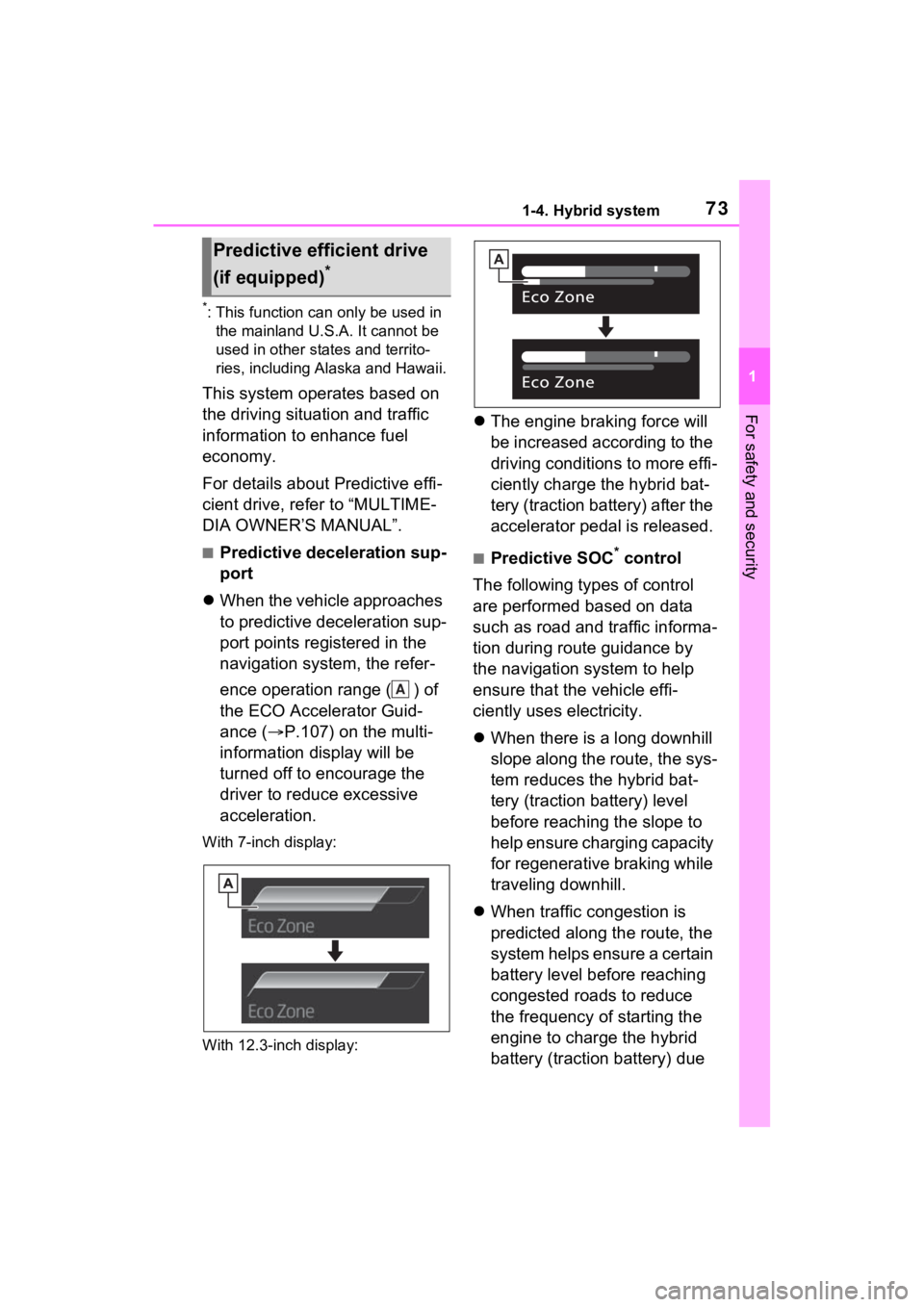
731-4. Hybrid system
1
For safety and security
*: This function can only be used in
the mainland U.S.A. It cannot be
used in other states and territo-
ries, including Alaska and Hawaii.
This system operates based on
the driving situation and traffic
information to enhance fuel
economy.
For details about Predictive effi-
cient drive, refer to “MULTIME-
DIA OWNER’S MANUAL”.
■Predictive deceleration sup-
port
When the vehicle approaches
to predictive deceleration sup-
port points registered in the
navigation system, the refer-
ence operation range ( ) of
the ECO Accelerator Guid-
ance ( P.107) on the multi-
information display will be
turned off to encourage the
driver to reduce excessive
acceleration.
With 7-inch display:
With 12.3-inch display:
The engine braking force will
be increased according to the
driving conditions to more effi-
ciently charge the hybrid bat-
tery (traction battery) after the
accelerator pedal is released.
■Predictive SOC* control
The following types of control
are performed based on data
such as road and traffic informa-
tion during route guidance by
the navigation system to help
ensure that the vehicle effi-
ciently uses electricity.
When there is a long downhill
slope along the route, the sys-
tem reduces the hybrid bat-
tery (traction battery) level
before reaching the slope to
help ensure charging capacity
for regenerative braking while
traveling downhill.
When traffic congestion is
predicted along the route, the
system helps ensure a certain
battery level before reaching
congested roads to reduce
the frequency of starting the
engine to charge the hybrid
battery (traction battery) due
Predictive efficient drive
(if equipped)
*
A
Page 489 of 586
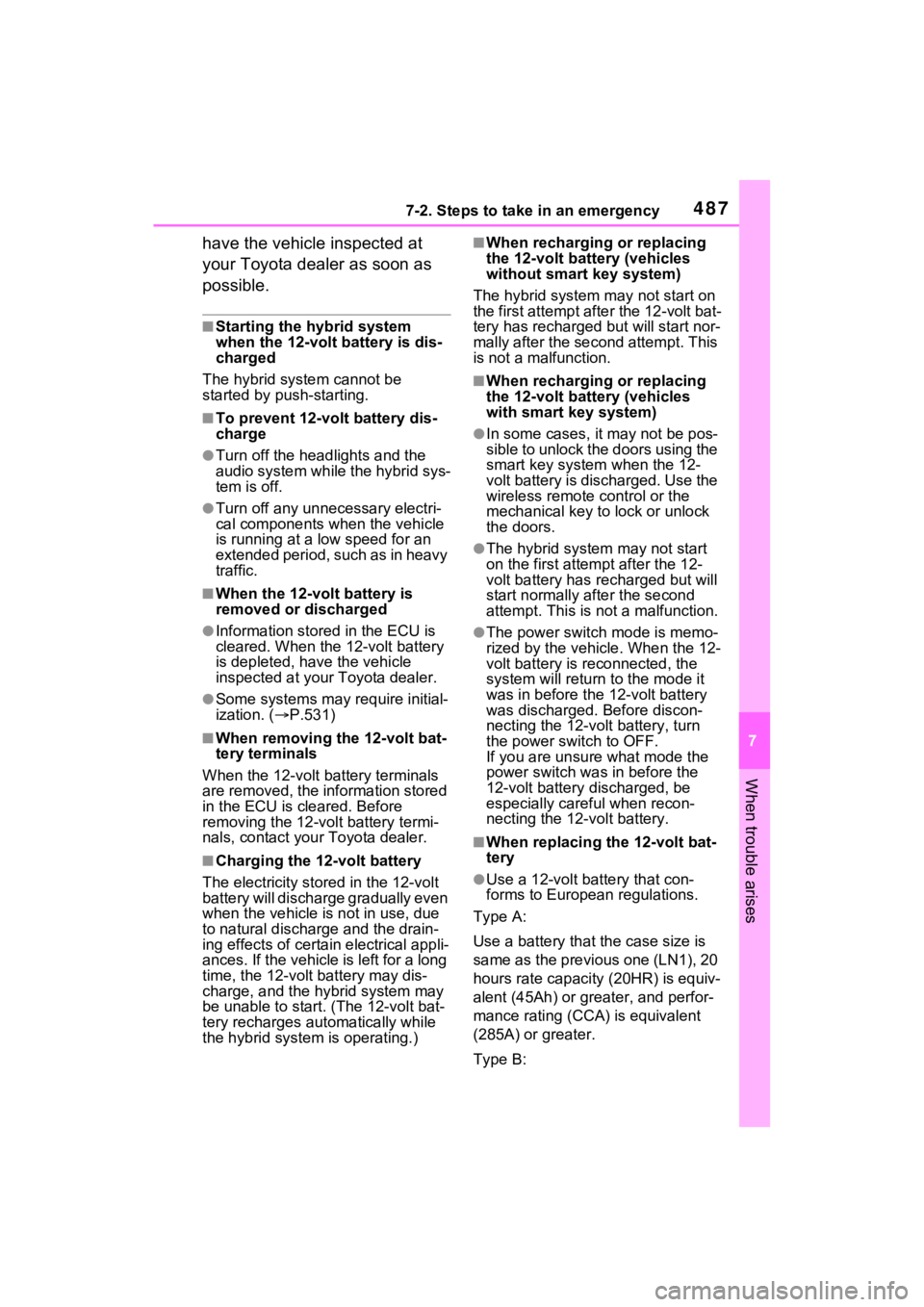
4877-2. Steps to take in an emergency
7
When trouble arises
have the vehicle inspected at
your Toyota dealer as soon as
possible.
■Starting the hybrid system
when the 12-volt battery is dis-
charged
The hybrid system cannot be
started by push-starting.
■To prevent 12-vol t battery dis-
charge
●Turn off the headlights and the
audio system while the hybrid sys-
tem is off.
●Turn off any unnec essary electri-
cal components when the vehicle
is running at a low speed for an
extended period, such as in heavy
traffic.
■When the 12-volt battery is
removed or discharged
●Information stor ed in the ECU is
cleared. When the 12-volt battery
is depleted, have the vehicle
inspected at your Toyota dealer.
●Some systems may require initial-
ization. ( P.531)
■When removing the 12-volt bat-
tery terminals
When the 12-volt battery terminals
are removed, the information stored
in the ECU is cleared. Before
removing the 12-volt battery termi-
nals, contact your Toyota dealer.
■Charging the 1 2-volt battery
The electricity stor ed in the 12-volt
battery will discharge gradually even
when the vehicle is not in use, due
to natural discharge and the drain-
ing effects of certa in electrical appli-
ances. If the vehicle is left for a long
time, the 12-volt battery may dis-
charge, and the hybrid system may
be unable to start. (The 12-volt bat-
tery recharges aut omatically while
the hybrid system is operating.)
■When recharging or replacing
the 12-volt battery (vehicles
without smart key system)
The hybrid system may not start on
the first attempt after the 12-volt bat-
tery has recharged but will start nor-
mally after the second attempt. This
is not a malfunction.
■When recharging or replacing
the 12-volt battery (vehicles
with smart key system)
●In some cases, it may not be pos-
sible to unlock the doors using the
smart key system when the 12-
volt battery is discharged. Use the
wireless remote c ontrol or the
mechanical key to lock or unlock
the doors.
●The hybrid syste m may not start
on the first attempt after the 12-
volt battery has recharged but will
start normally after the second
attempt. This is n ot a malfunction.
●The power switch mode is memo-
rized by the vehicle. When the 12-
volt battery is reconnected, the
system will return to the mode it
was in before the 12-volt battery
was discharged. Before discon-
necting the 12-volt battery, turn
the power switch to OFF.
If you are unsure what mode the
power switch was in before the
12-volt battery discharged, be
especially careful when recon-
necting the 12-volt battery.
■When replacing t he 12-volt bat-
tery
●Use a 12-volt battery that con-
forms to European regulations.
Type A:
Use a battery that the case size is
same as the previous one (LN1), 20
hours rate capacity (20HR) is equiv-
alent (45Ah) or greater, and perfor-
mance rating (CCA) is equivalent
(285A) or greater.
Type B:
Page 490 of 586
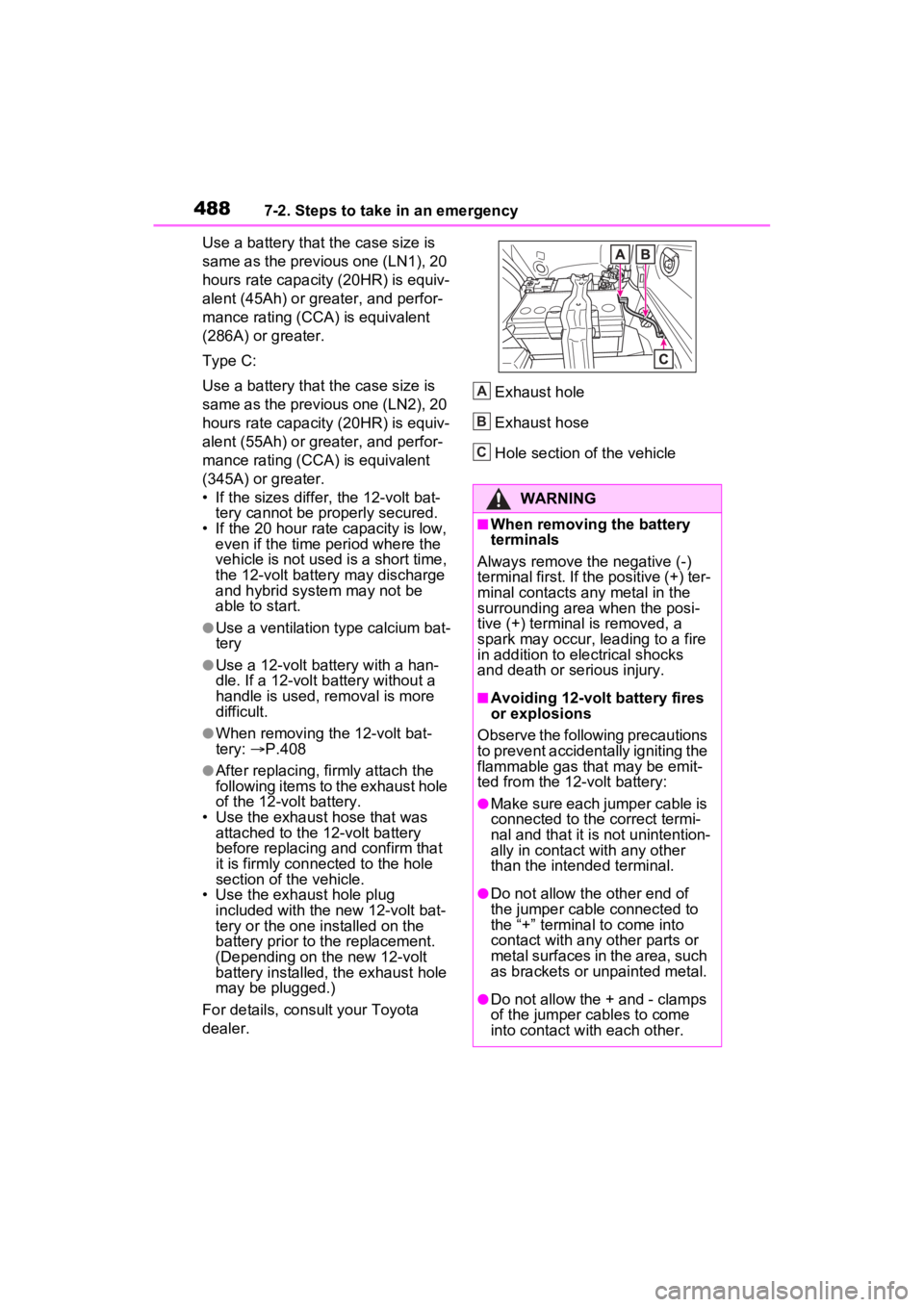
4887-2. Steps to take in an emergency
Use a battery that the case size is
same as the previous one (LN1), 20
hours rate capacity (20HR) is equiv-
alent (45Ah) or greater, and perfor-
mance rating (CCA) is equivalent
(286A) or greater.
Type C:
Use a battery that the case size is
same as the previous one (LN2), 20
hours rate capacity (20HR) is equiv-
alent (55Ah) or greater, and perfor-
mance rating (CCA) is equivalent
(345A) or greater.
• If the sizes differ, the 12-volt bat-
tery cannot be properly secured.
• If the 20 hour rate capacity is low,
even if the time period where the
vehicle is not used is a short time,
the 12-volt battery may discharge
and hybrid system may not be
able to start.
●Use a ventilation t ype calcium bat-
tery
●Use a 12-volt battery with a han-
dle. If a 12-volt b attery without a
handle is used, removal is more
difficult.
●When removing the 12-volt bat-
tery: P.408
●After replacing, firmly attach the
following items to the exhaust hole
of the 12-volt battery.
• Use the exhaust hose that was attached to the 12-volt battery
before replacing an d confirm that
it is firmly connected to the hole
section of t he vehicle.
• Use the exhaust hole plug included with the new 12-volt bat-
tery or the one installed on the
battery prior to t he replacement.
(Depending on the new 12-volt
battery installed, the exhaust hole
may be plugged.)
For details, consult your Toyota
dealer. Exhaust hole
Exhaust hose
Hole section of the vehicle
WARNING
■When removing the battery
terminals
Always remove the negative (-)
terminal first. If the positive (+) ter-
minal contacts any metal in the
surrounding area when the posi-
tive (+) terminal is removed, a
spark may occur, leading to a fire
in addition to ele ctrical shocks
and death or serious injury.
■Avoiding 12-volt battery fires
or explosions
Observe the following precautions
to prevent accidentally igniting the
flammable gas that may be emit-
ted from the 12-volt battery:
●Make sure each jumper cable is
connected to the correct termi-
nal and that it is not unintention-
ally in contact with any other
than the intended terminal.
●Do not allow the other end of
the jumper cable connected to
the “+” terminal to come into
contact with any other parts or
metal surfaces in the area, such
as brackets or unpainted metal.
●Do not allow the + and - clamps
of the jumper cables to come
into contact with each other.
A
B
C
Page 500 of 586
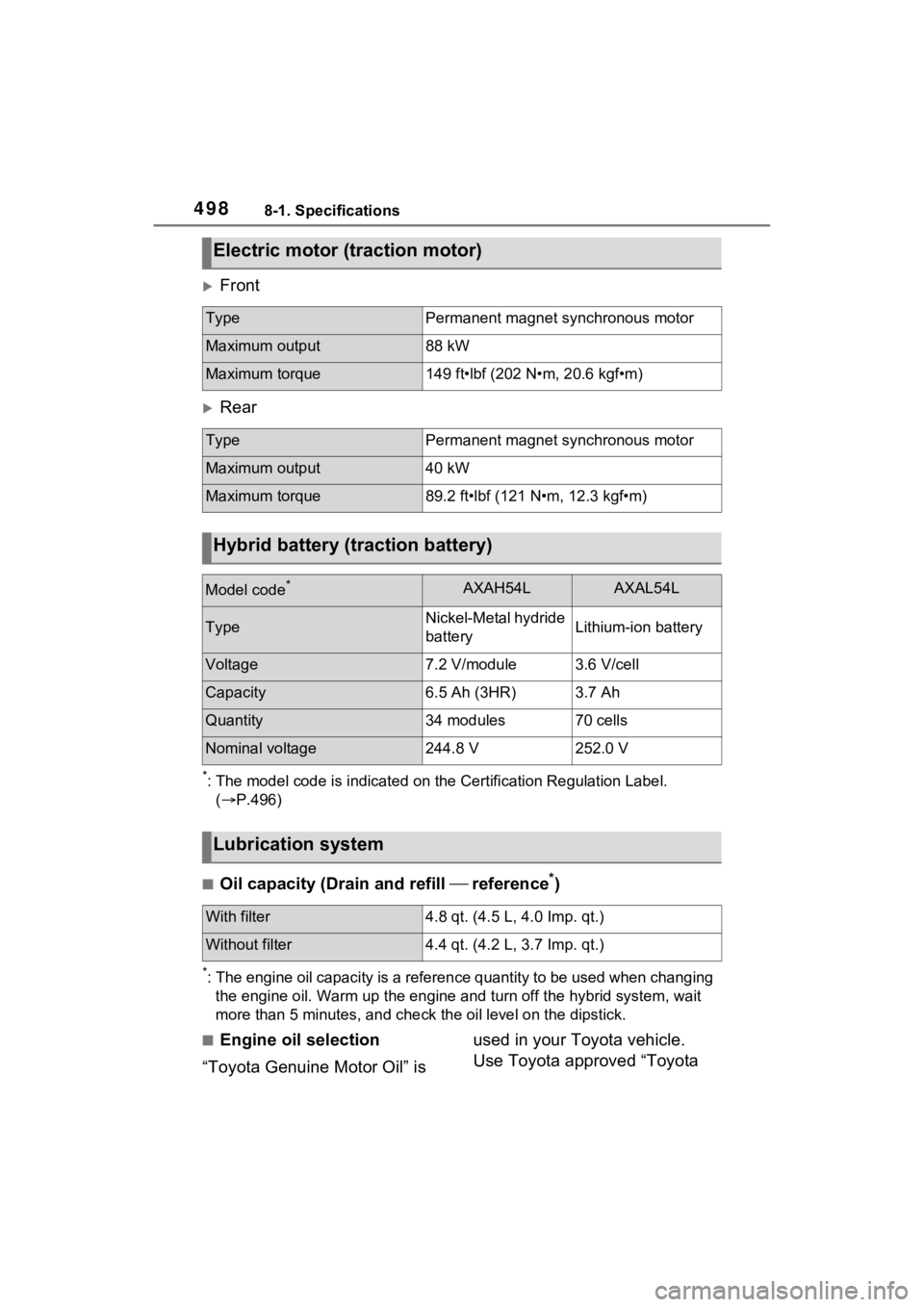
4988-1. Specifications
Front
Rear
*: The model code is indicated on the Certification Regulation Label.
( P.496)
■Oil capacity (Drain and refill reference*)
*: The engine oil capacity is a reference quantity to be used whe n changing
the engine oil. Warm up the engine and turn off the hybrid system, wait
more than 5 minutes, a nd check the oil level on the dipstick.
■Engine oil selection
“Toyota Genuine Motor Oil” is used in your Toyota vehicle.
Use Toyota approved “Toyota
Electric motor (traction motor)
TypePermanent magnet synchronous motor
Maximum output88 kW
Maximum torque149 ft•lbf (202 N•m, 20.6 kgf•m)
TypePermanent magnet synchronous motor
Maximum output40 kW
Maximum torque89.2 ft•lbf (121 N•m, 12.3 kgf•m)
Hybrid battery (traction battery)
Model code*AXAH54LAXAL54L
TypeNickel-Metal hydride
batteryLithium-ion battery
Voltage7.2 V/module3.6 V/cell
Capacity6.5 Ah (3HR)3.7 Ah
Quantity34 modules70 cells
Nominal voltage244.8 V252.0 V
Lubrication system
With filter4.8 qt. (4.5 L
, 4.0 Imp. qt.)
Without filter4.4 qt. (4.2 L, 3.7 Imp. qt.)
Page 502 of 586
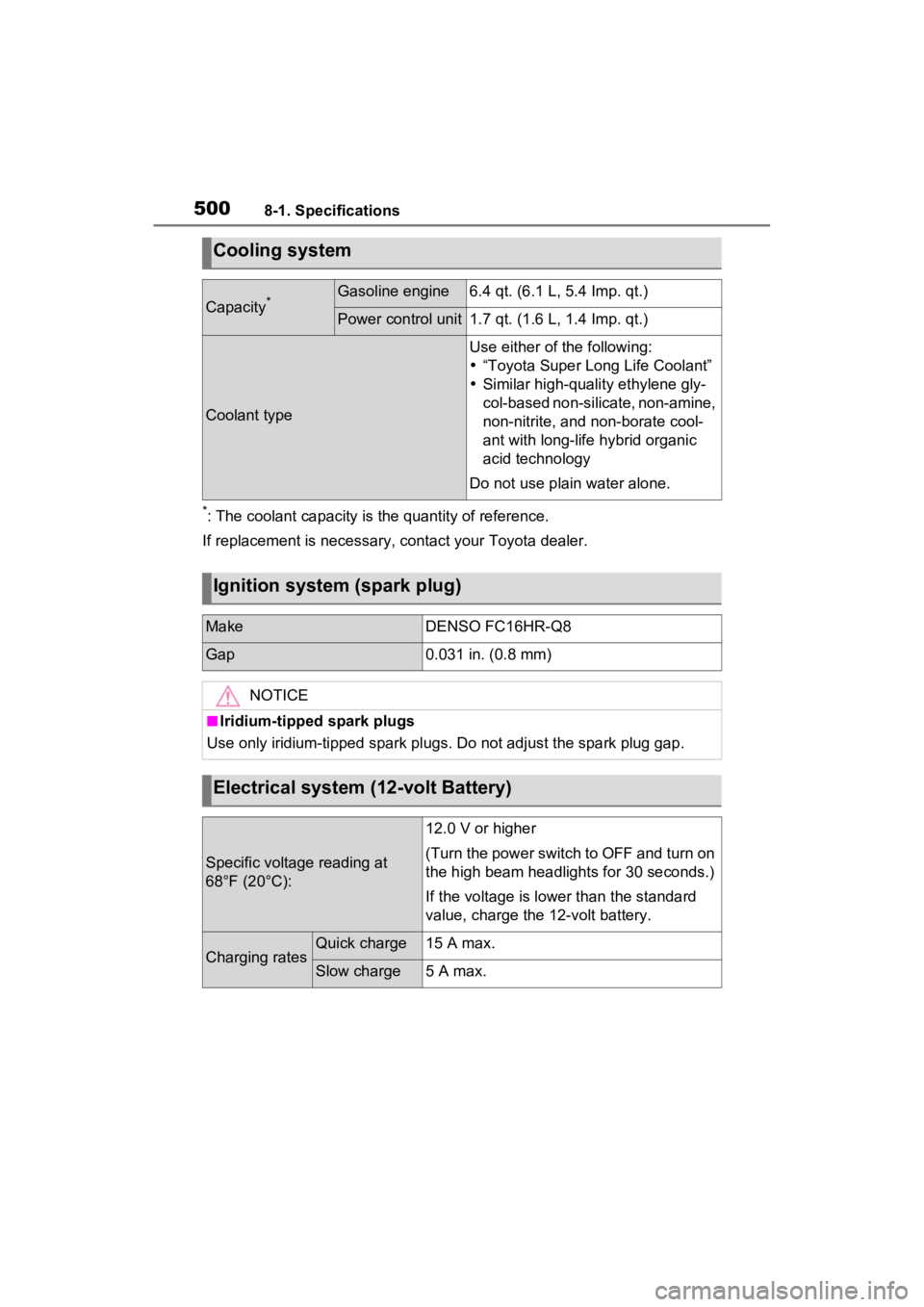
5008-1. Specifications
*: The coolant capacity is the quantity of reference.
If replacement is necessary, contact y our Toyota dealer.
Cooling system
Capacity*Gasoline engine6.4 qt. (6.1 L, 5.4 Imp. qt.)
Power control unit1.7 qt. (1.6 L, 1.4 Imp. qt.)
Coolant type
Use either of the following:
“Toyota Super Long Life Coolant”
Similar high-quality ethylene gly-
col-based non-silicate, non-amine,
non-nitrite, and non-borate cool-
ant with long-life hybrid organic
acid technology
Do not use plain water alone.
Ignition system (spark plug)
MakeDENSO FC16HR-Q8
Gap0.031 in. (0.8 mm)
NOTICE
■Iridium-tipped spark plugs
Use only iridium-tipped spark plugs. Do not adjust the spark pl ug gap.
Electrical system (12-volt Battery)
Specific voltage reading at
68°F (20°C):
12.0 V or higher
(Turn the power switch to OFF and turn on
the high beam headlights for 30 seconds.)
If the voltage is lower than the standard
value, charge the 12-volt battery.
Charging ratesQuick charge15 A max.
Slow charge5 A max.
Page 514 of 586
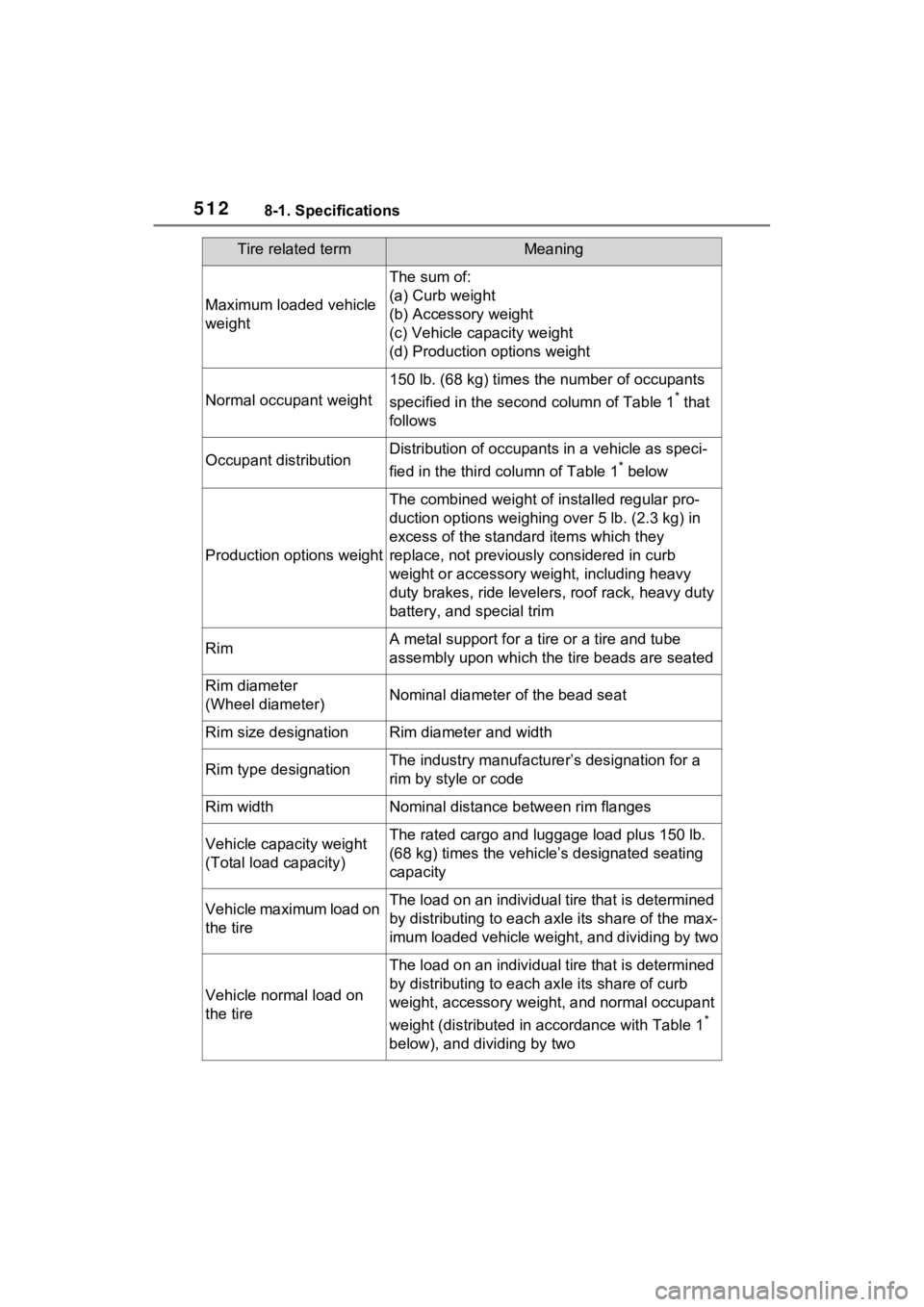
5128-1. Specifications
Maximum loaded vehicle
weight
The sum of:
(a) Curb weight
(b) Accessory weight
(c) Vehicle capacity weight
(d) Production options weight
Normal occupant weight
150 lb. (68 kg) times the number of occupants
specified in the second column of Table 1
* that
follows
Occupant distributionDistribution of occupant s in a vehicle as speci-
fied in the third column of Table 1
* below
Production options weight
The combined weight of installed regular pro-
duction options weighing over 5 lb. (2.3 kg) in
excess of the standard items which they
replace, not previously considered in curb
weight or accessory weight, including heavy
duty brakes, ride leveler s, roof rack, heavy duty
battery, and special trim
RimA metal support for a ti re or a tire and tube
assembly upon which the tire beads are seated
Rim diameter
(Wheel diameter)Nominal diameter o f the bead seat
Rim size designationRim diameter and width
Rim type designationThe industry manufacture r’s designation for a
rim by style or code
Rim widthNominal distance between rim flanges
Vehicle capacity weight
(Total load capacity)The rated cargo and luggage load plus 150 lb.
(68 kg) times the vehicl e’s designated seating
capacity
Vehicle maximum load on
the tireThe load on an individual tire that is determined
by distributing to each ax le its share of the max-
imum loaded vehicle weight, and dividing by two
Vehicle normal load on
the tire
The load on an individual tire that is determined
by distributing to each axle its share of curb
weight, accessory weight, and normal occupant
weight (distributed in accordance with Table 1
*
below), and dividing by two
Tire related termMeaning
Page 554 of 586

552Alphabetical Index
Replacing light bulbs ............ 439
Wattage ................................ 504
Battery (12-volt battery) ......... 407 If the 12-volt battery is dis-charged .............................. 485
Preparing and c hecking before
winter.................................. 334
Replacing ............................. 487
Warning light ........................ 456
Battery (traction battery) ......... 75
Blind Spot Monitor (BSM) ...... 293 Blind Spot Monitor function .. 296
Bottle holders ......................... 357
Brake Brake Hold ........................... 235
Fluid ..................................... 405
Parking brake ....................... 231
Regenerative braking ............. 71
Warning light ........................ 456
Brake assist ............................ 326
Brake Hold .............................. 235
Break-in tips ........ ................... 196
Brightness control Instrument panel light control97, 104
BSM (Blind Spot Monitor) ...... 293 Blind Spot Monitor function .. 296
C
CareAluminum wheels ................. 384
Exterior ................................. 384
Interior .................................. 387
Seat belts ............................. 387
Cargo capacity ............... 202, 205
Cargo hooks ........................... 359
Chains ..................................... 336
Child-protectors ..................... 140
Child restraint s ystem ............. 50
Fixed with a LATCH system ... 59
Fixed with a seat belt ............. 54
Front passenger occupant clas- sification system ...................43
Points to remember ................50
Riding with children ................49
Types of child restraint system installation method ...............52
Using an anchor bracket ........61
Child safety ...............................49 12-volt battery precautions .407, 489
Airbag precautions .................38
Back door precautions..........141
Child restraint system .............52
Heated steering wheel and seat heater precautio ns..............349
How your child should wear the seat belt ................................30
Moon roof precautions..........187
Panoramic moon roof precau- tions ....................................191
Power window lock switch ....185
Power window precautions...184
Rear door child-protectors ....140
Removed key battery precau- tions ....................................435
Seat belt extender precautions .............................................30
Seat belt precautions..............29
Seat heater precautions .......349
Cleaning ..........................384, 387 Aluminum wheels .................384
Exterior .................................384
Interior ..................................387
Radar sensor ................253, 294
Seat belts .............................387
Clock ..........................................99
Coat hooks ..............................374
Condenser ............. ..................404
Console box ............................356
Consumption screen ..............125
Convenience Services (Sugges- tion function).........................114
Coolant
Page 556 of 586

554Alphabetical Index
with full-speed rangeFunction ............................... 282
Warning message ................ 466
E
ECB (Electronically Controlled Brake System) ...................... 326
Eco drive mode ...................... 323
EDR (Event data recorder)......... 8
E-Four (Electronic On-Demand AWD system) ........................ 327
Elapsed time ................... 109, 120
Electric motor Location.................................. 70
Specification ......................... 498
Electric Power Steering (EPS) Function ............................... 327
Warning light ........................ 458
Electronically Controlled Brake System (ECB) ....................... 326
Electronic key Battery-saving function......... 156
If the electronic key does not operate properly ................. 483
Replacing the battery ........... 433
Electronic sunshade .............. 189 Jam protection function ........ 190
Operation ............................. 189
Emergency, in case of If a warning buzzer sounds .. 456
If a warning light turns on ..... 456
If a warning message is dis-played................................. 466
If the 12-volt battery is dis- charged .............................. 485
If the electronic key does not operate properly ................. 483
If the fuel filler door cannot be opened ............................... 482
If the hybrid sy stem will not start
........................................... 480
If the vehicle is submerged or water on the road is rising ..450
If you have a flat tire .............471
If you lose your keys.............481
If you think something is wrong ...........................................455
If your vehicle becomes stuck ...........................................493
If your vehicle has to be stopped in an emergency .................449
If your vehicle needs to be towed ...........................................451
If your vehicle ove rheats ......490
Emergency flashers ...............448
Energy monitor .......................125
Engine Compartment........................401
Hood .....................................398
Identification number ............497
Tachometer ............................99
Engine coolant Capacity ...............................500
Checking ..............................403
Preparing and checking before winter ..................................334
Warning light ........................457
Engine coolant temperature ..93, 99
Engine oil Capacity ...............................498
Checking ..............................401
Preparing and checking before winter ..................................334
Warning light ........................457
Enhanced Vehicle Stability Con- trol (Enhanced VSC ) .............326
Enhanced VSC (Enhanced Vehi- cle Stability Control).............326
EPS (Electric Po wer Steering)
Function................................327
Warning light ........................458
EV drive mode.........................224
Event data recorder (EDR) .........8
Page 562 of 586
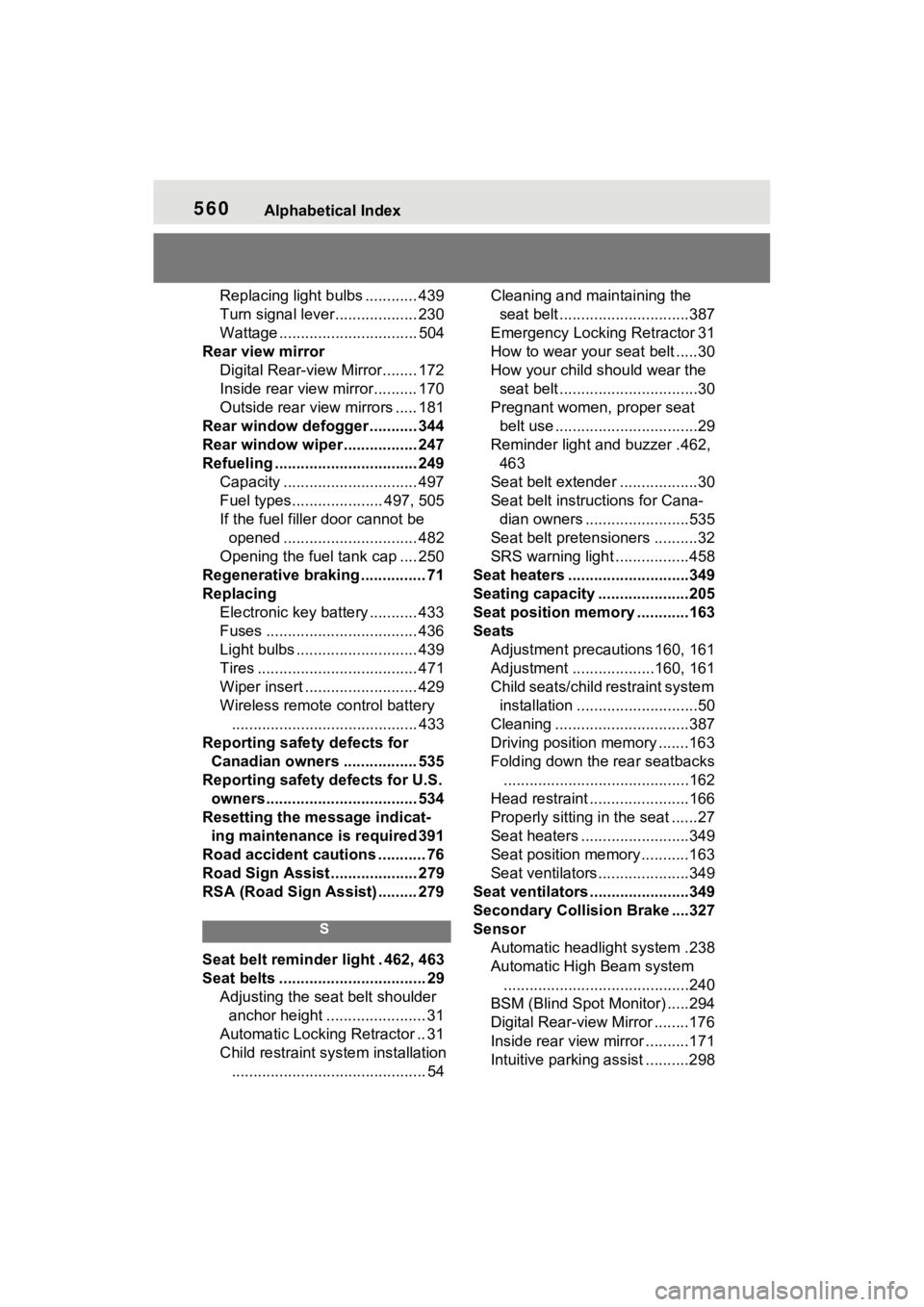
560Alphabetical Index
Replacing light bulbs ............ 439
Turn signal lever................... 230
Wattage ................................ 504
Rear view mirror Digital Rear-view Mirror........ 172
Inside rear view mirror.......... 170
Outside rear view mirrors ..... 181
Rear window defogger ........... 344
Rear window wiper ................. 247
Refueling ................................. 249 Capacity ............................... 497
Fuel types..................... 497, 505
If the fuel filler door cannot be opened ............................... 482
Opening the fuel tank cap .... 250
Regenerative braking ............... 71
Replacing Electronic key battery ........... 433
Fuses ................................... 436
Light bulbs ............................ 439
Tires ..................................... 471
Wiper insert .......................... 429
Wireless remote control battery........................................... 433
Reporting safety defects for Canadian owners ................. 535
Reporting safety defects for U.S. owners................................... 534
Resetting the message indicat- ing maintenance is required 391
Road accident cautions ........... 76
Road Sign Assist .................... 279
RSA (Road Sign Assist) ......... 279
S
Seat belt reminder light . 462, 463
Seat belts .................................. 29 Adjusting the seat belt shoulder anchor height ....................... 31
Automatic Locking Retractor .. 31
Child restraint system installation ............................................. 54 Cleaning and maintaining the
seat belt ..............................387
Emergency Locking Retractor 31
How to wear your seat belt .....30
How your child should wear the seat belt ................................30
Pregnant women, proper seat belt use .................................29
Reminder light and buzzer .462, 463
Seat belt extender ..................30
Seat belt instructions for Cana- dian owners ........................535
Seat belt pretensioners ..........32
SRS warning light .................458
Seat heaters ............................349
Seating capacity .....................205
Seat position memory ............163
Seats Adjustment precautions 160, 161
Adjustment ...................160, 161
Child seats/child restraint system installation ............................50
Cleaning ...............................387
Driving position memory .......163
Folding down the rear seatbacks ...........................................162
Head restraint .......................166
Properly sitting in the seat ......27
Seat heaters ....... ..................349
Seat position memory...........163
Seat ventilators.....................349
Seat ventilators .. .....................349
Secondary Collision Brake ....327
Sensor Automatic headlight system .238
Automatic High Beam system...........................................240
BSM (Blind Spot M onitor) .....294
Digital Rear-view Mirror ........176
Inside rear view mirror ..........171
Intuitive parking assist ..........298
Page 566 of 586

564Alphabetical Index
Inappropriate pedal operation........................................... 461
Intuitive parking assist OFF indi- cator ................................... 459
Low engine oil pressure ....... 457
Low fuel level ....................... 462
LTA indicator ........................ 459
Malfunction indicator lamp ... 457
Parking brake indicator ........ 461
PCS warning light................. 459
PKSB (Parking Support Brake) ........................................... 460
PKSB OFF indicato r ............. 460
RCTA OFF indicator............. 460
Seat belt reminder light 462, 463
Slip indicator......................... 460
SRS ...................................... 458
Tire pressure ........................ 462
Warning messages ................ 466
Washer Checking .............................. 406
Low washer fluid warning mes-sage ........................... 406, 466
Preparing and c hecking before
winter.................................. 334
Switch........................... 244, 247
Washing and waxing .............. 384
Weight Cargo capacity ............. 202, 205
Load limits ............................ 205
Weight .................................. 496
Wheels ..................................... 422 Replacing wheels ................. 422
Size ...................................... 502
Window glasses Power windows .................... 183
Window lock switch ............... 185
Windows Power windows .................... 183
Rear window defogger ......... 344
Washer ......................... 244, 247
Windshield defogger .............. 344 Windshield wiper d
e-icer .......347
Windshield wipers Intermittent windshield wipers...........................................244
Position.........................244, 247
Rain-sensing windshield wipers ...........................................244
Replacing the wiper insert ....429
Winter driving tips ..................334
Wiper insert .............................429
Wireless charger.....................366
Wireless remote control.........132 Battery-saving function .........156
Locking/Unlocking ................132
Panic mode ..........................133
Replacing the battery ...........433
For information regarding the equipment listed
below, refer to the “MUL-
TIMEDIA OWNER’S MAN-
UAL”.
· Navigation system
· Audio system